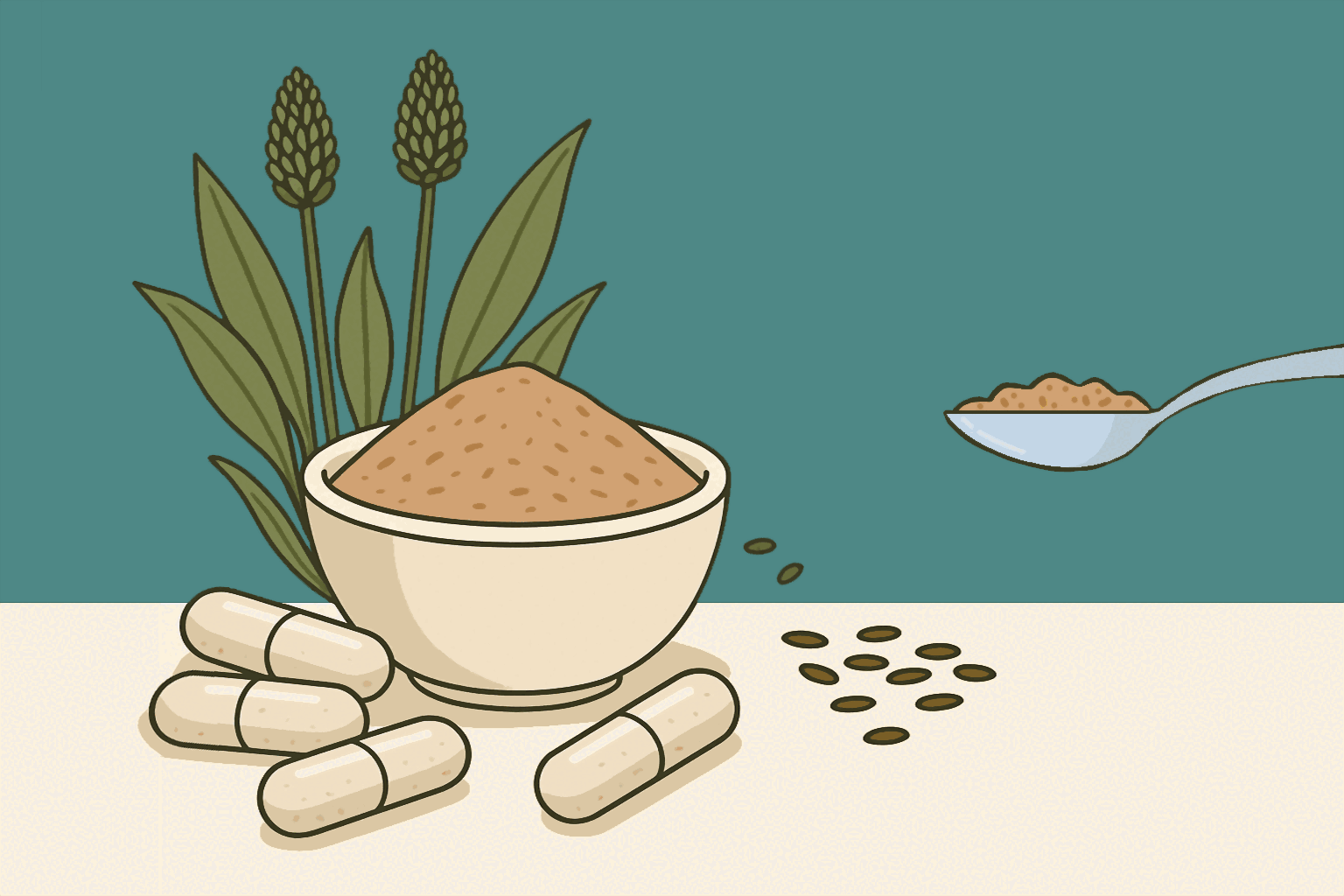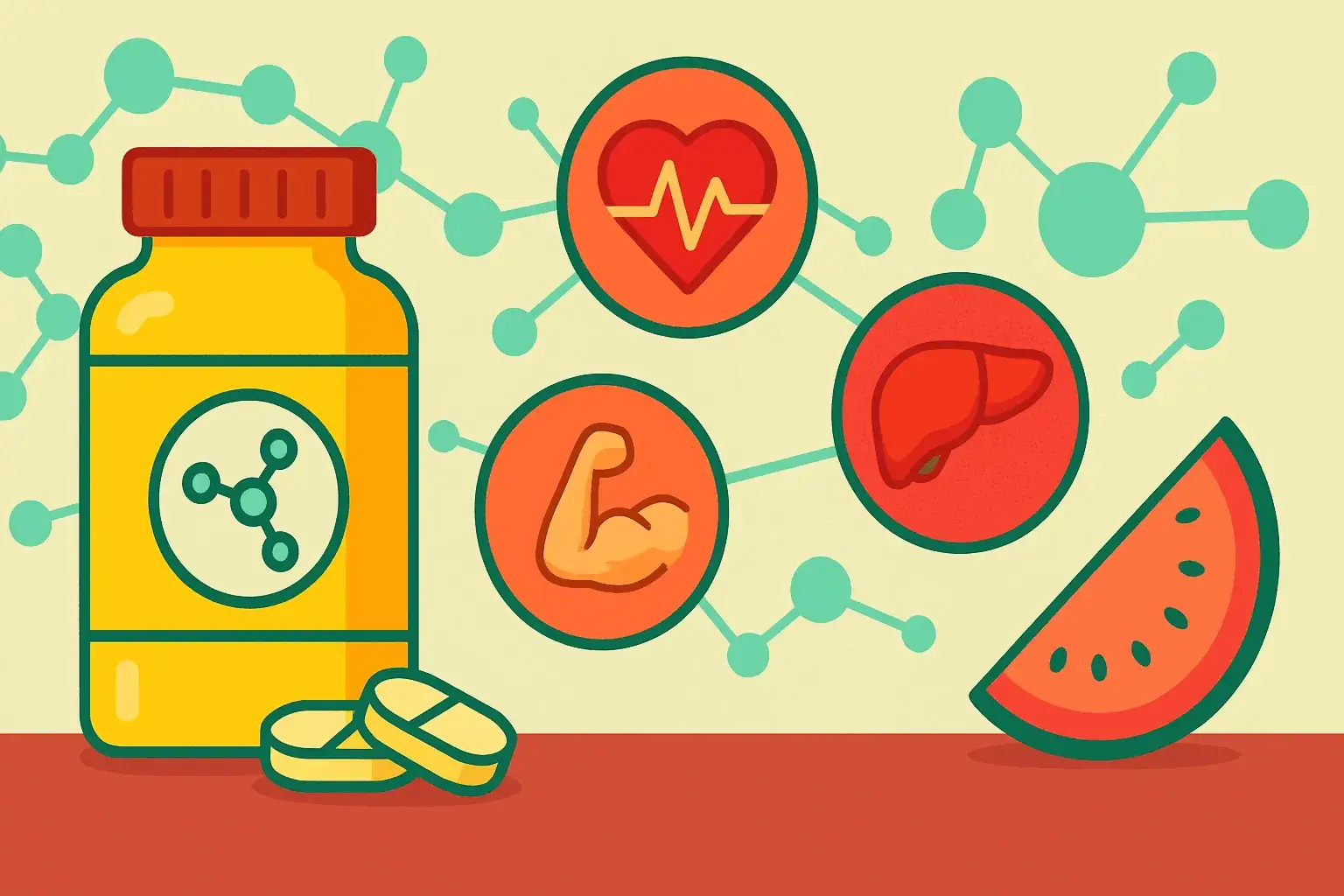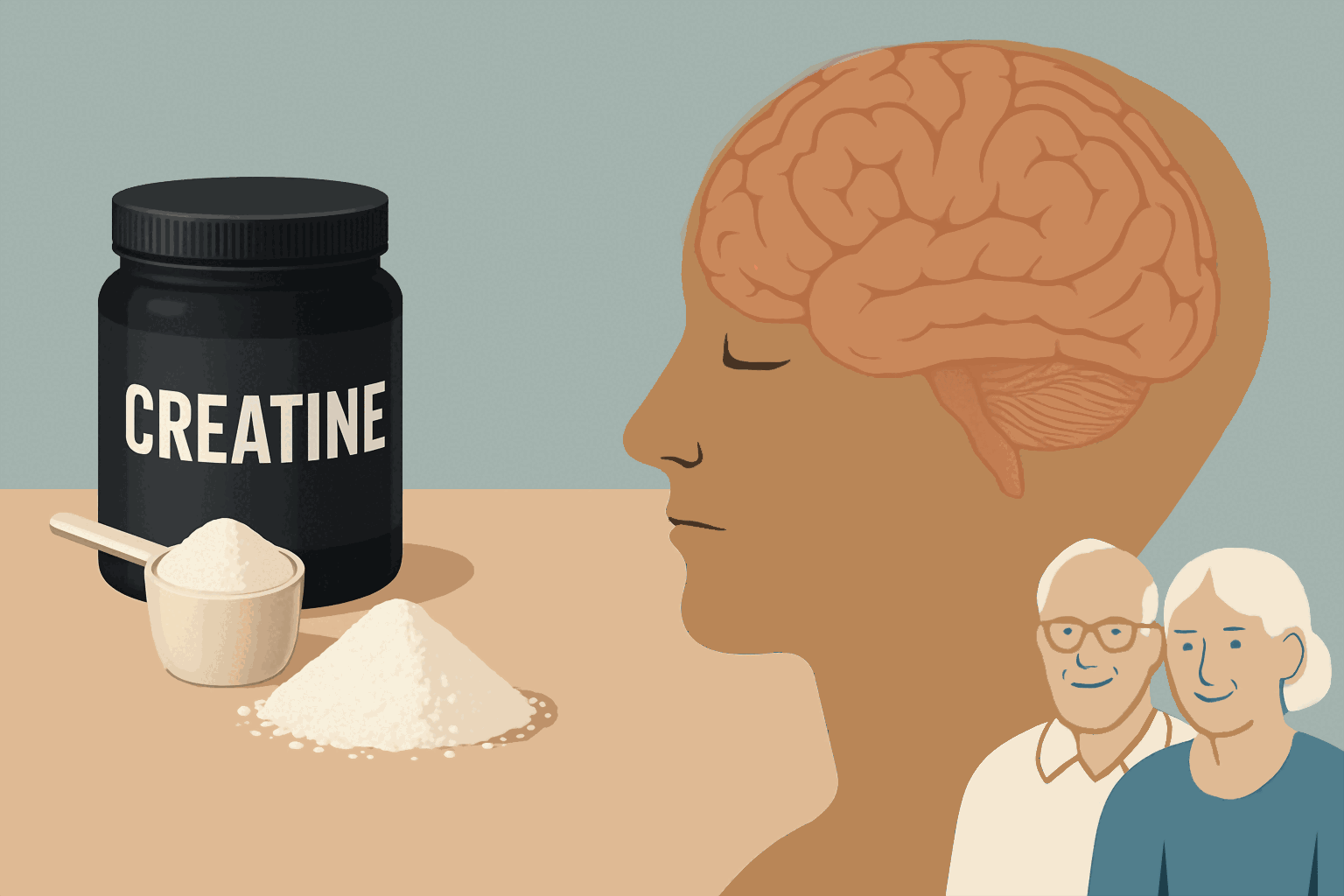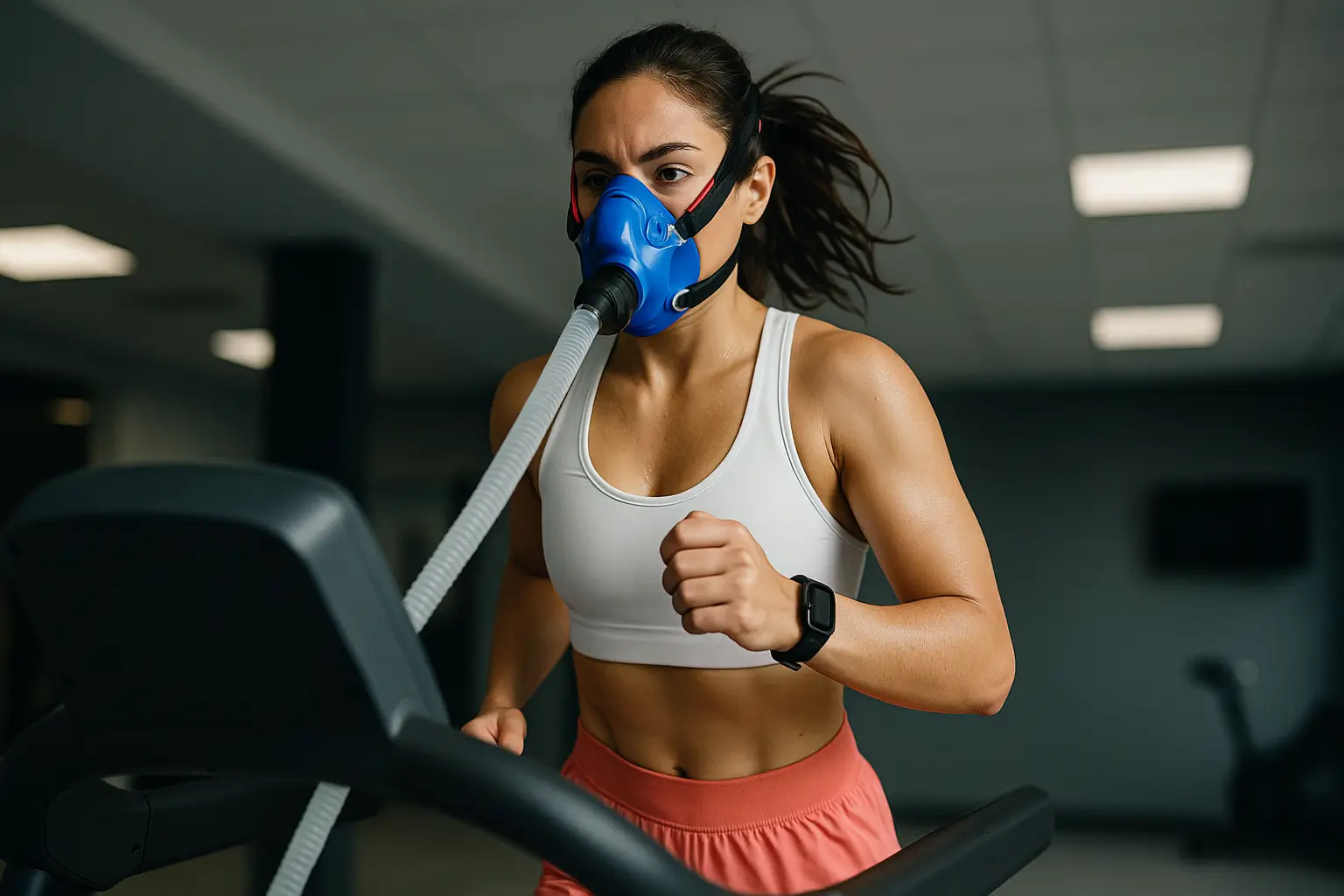
The Power of High-Intensity Short Workouts: Boosting VO2 Max for Health and Longevity
- Marcus Reed
- Health , Fitness , Science , Wellness
- May 20, 2025
Table of Contents
Fast Facts: HIIT & VO2 Max (TL;DR)
- VO2 Max is Key: It’s the top measure of cardiorespiratory fitness, linked to lower disease risk and longer life.
- HIIT Superiority: High-Intensity Interval Training boosts VO2 Max more effectively and quickly than traditional steady-state cardio.
- How HIIT Works: It improves heart output, cellular energy production (mitochondria), oxygen delivery, and metabolic flexibility.
- Proven Protocols: Regimens like 15s on/15s off, 4-min intervals (4x4), and all-out sprints (SIT) are effective.
- Safety First: Calculate your approximate max heart rate (220-age), warm up, progress gradually, and consult a doctor if needed.
- Beyond Fitness: Higher VO2 Max from HIIT contributes to reduced risks of heart disease, type 2 diabetes, and neurodegenerative conditions.
- Consistency is Crucial: Aim for 2-3 HIIT sessions per week, balanced with recovery and other forms of exercise.
Understanding VO2 Max: The Gold Standard of Cardiovascular Health
VO2 Max, or maximal oxygen uptake, stands as the premier, scientifically recognized benchmark for assessing an individual’s cardiorespiratory fitness. It precisely quantifies the absolute maximum volume of oxygen your body can effectively absorb, transport, and utilize during strenuous, exhaustive exercise. Measured in milliliters of oxygen per kilogram of body weight per minute (mL/kg/min), $VO_2$ Max is a powerful indicator of overall aerobic endurance and physical conditioning. This crucial metric offers a holistic view of how efficiently several physiological systems work in concert:
- Pulmonary System: The lungs’ capacity to take in oxygen from the air and transfer it to the bloodstream.
- Cardiovascular System: The heart’s ability to pump oxygen-rich blood to the working muscles, and the vascular system’s efficiency in delivering it.
- Muscular System: The muscles’ (specifically, their mitochondria) proficiency in extracting and using that oxygen to produce adenosine triphosphate (ATP), the energy currency of cells.
A higher $VO_2$ Max isn’t just for athletes; it’s strongly correlated with improved health outcomes, including significantly reduced risks of developing cardiovascular disease, metabolic syndrome, certain types of cancer, and all-cause mortality [7], [9]. For context, elite endurance athletes often boast $VO_2$ Max values exceeding 70 mL/kg/min, whereas individuals with a more sedentary lifestyle may typically score below 40 mL/kg/min.
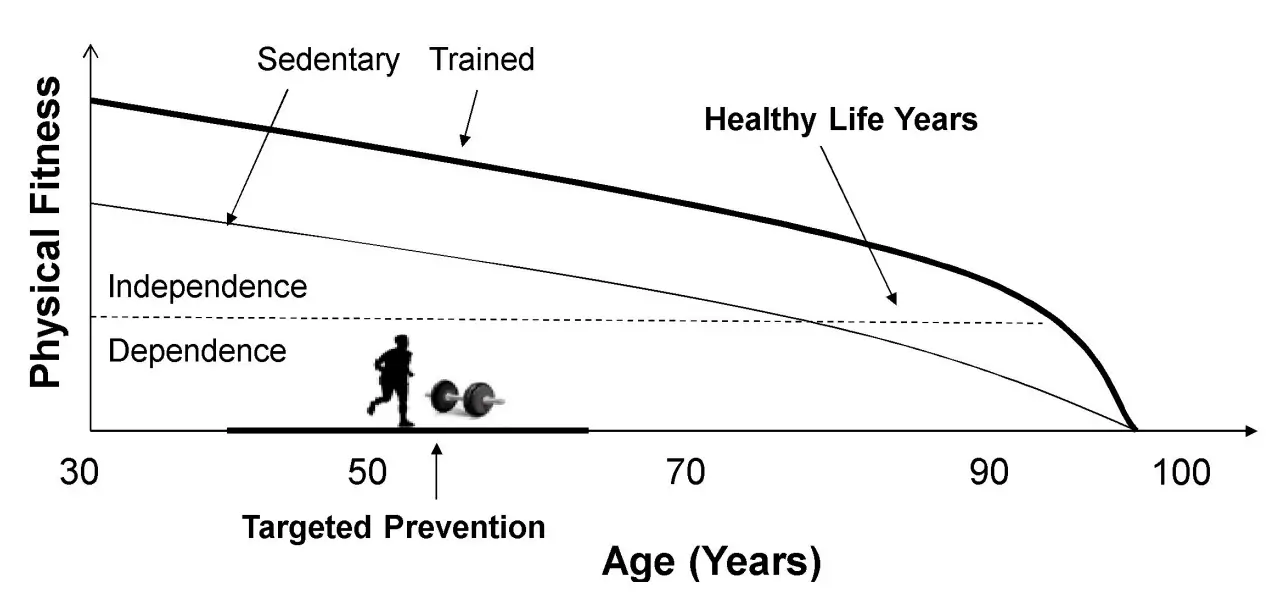 Hypothesis of physical fitness (cardiorespiratory fitness and muscle strength) on Healthy Life Years (disability-free life expectancy) in trained
versus sedentary subjects. The dotted line represents the prognostic exercise capacity generally necessary for an independent lifestyle and associated
with an increased risk for mortality. The cut-off values are: 17.5. ml/kg/min (5 METs) for aerobic capacity (28); 30 kg and 18 kg for grip strength in men
and women aged over 65 years, respectively [10].
Hypothesis of physical fitness (cardiorespiratory fitness and muscle strength) on Healthy Life Years (disability-free life expectancy) in trained
versus sedentary subjects. The dotted line represents the prognostic exercise capacity generally necessary for an independent lifestyle and associated
with an increased risk for mortality. The cut-off values are: 17.5. ml/kg/min (5 METs) for aerobic capacity (28); 30 kg and 18 kg for grip strength in men
and women aged over 65 years, respectively [10].
Why HIIT Outperforms Steady-State Cardio for VO2 Max Enhancement
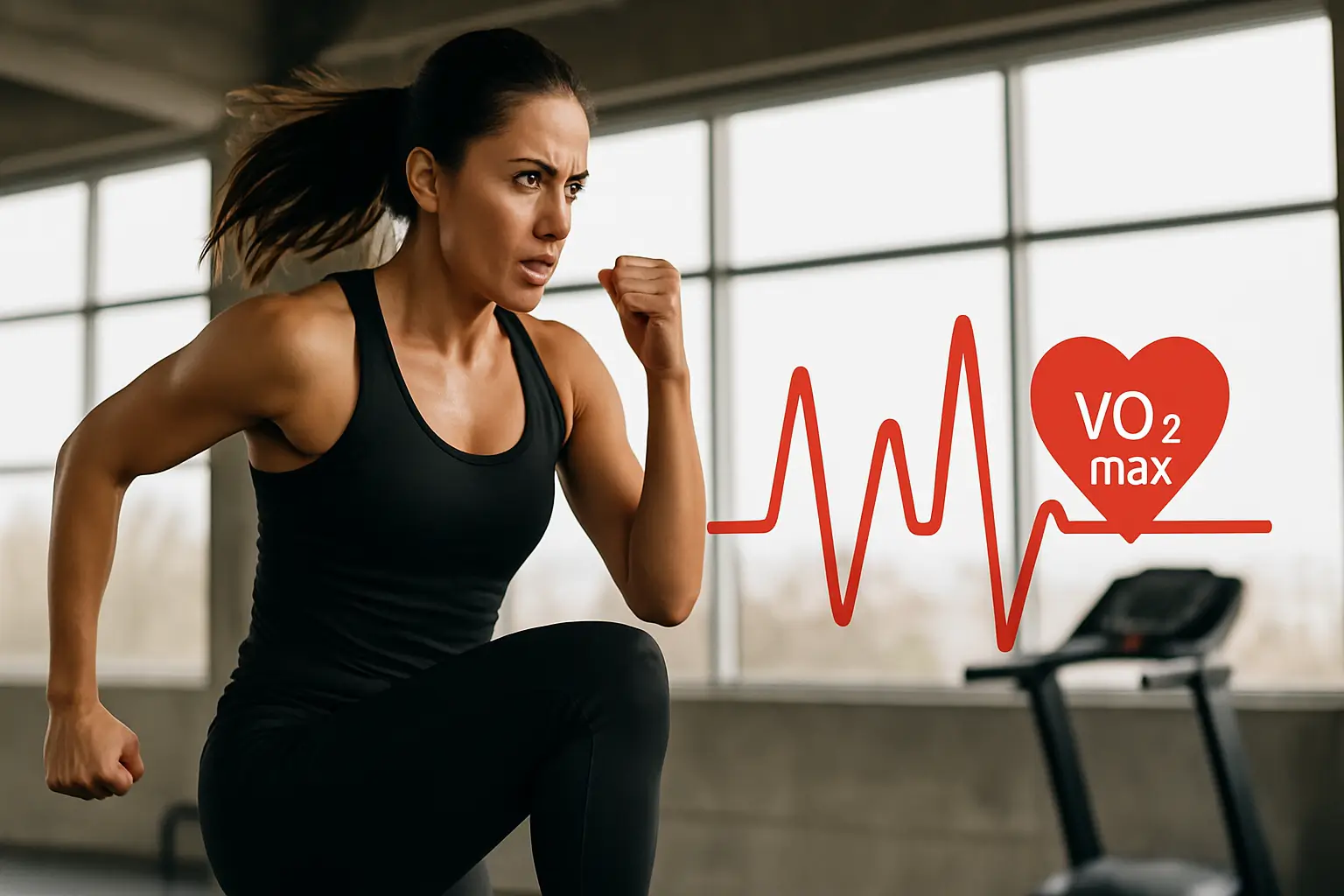
While traditional moderate-intensity continuous training (MICT), often referred to as steady-state cardio, certainly provides recognized health benefits, high-intensity interval training (HIIT) has consistently demonstrated an ability to elicit superior improvements in $VO_2$ Max, often in a significantly shorter timeframe [1]. This makes HIIT a potent strategy for those seeking efficient and effective cardiovascular conditioning. The key advantages of HIIT stem from its unique physiological demands:
Mechanistic Benefits of HIIT
- Enhanced Cardiac Output: HIIT can increase stroke volume (the amount of blood pumped per heartbeat) by approximately 10% due to the repeated high-intensity efforts, leading to a more efficient heart [1].
- Boosted Mitochondrial Biogenesis: HIIT is a powerful stimulus for the creation of new mitochondria, the powerhouses within your cells. This process is largely mediated by the activation of PGC-1$\alpha$ (Peroxisome proliferator-activated receptor-gamma coactivator 1-alpha), a master regulator of mitochondrial growth and function. More mitochondria mean a greater capacity for aerobic energy production [3].
- Increased Capillary Density: HIIT promotes angiogenesis, the formation of new capillaries (tiny blood vessels) in the muscles. This increased vascularization improves the delivery of oxygen and nutrients to active muscle tissues and facilitates the removal of metabolic byproducts.
- Improved Metabolic Flexibility: HIIT enhances the body’s ability to efficiently switch between fuel sources, primarily carbohydrates and fats, during exercise and at rest. This includes boosting fat oxidation rates and improving insulin sensitivity, which aids in glucose regulation and can be beneficial for metabolic health [3].
Unparalleled Time Efficiency
The time-efficient nature of HIIT is a significant draw. Compelling evidence from meta-analyses indicates that even short-term HIIT protocols (as brief as 2 to 4 weeks), involving minimal total high-intensity work (sometimes less than 10 minutes per session), can yield measurable and statistically significant gains in $VO_2$ Max [2]. For more profound and sustained adaptations, research suggests that longer-term programs (12 weeks or more), particularly those incorporating somewhat longer high-intensity intervals (e.g., 2 to 4 minutes), tend to produce the most substantial improvements in cardiorespiratory fitness [3].
Evidence-Based HIIT Protocols for VO2 Max Optimization
While the best protocol can depend on individual fitness levels, preferences, and available time, several evidence-backed options have consistently shown excellent results for improving $VO_2$ Max. Always remember to pair these protocols with an adequate warm-up and cool-down.
1. The 15x15 Protocol (Norwegian Short Intervals)
- Structure: 15 seconds of high-intensity work (e.g., sprinting or cycling) at 90-95% of your maximum heart rate (HRmax), followed immediately by 15 seconds of active recovery (e.g., light jogging or slow pedaling) at around 70% HRmax.
- Volume: Repeat this cycle continuously. A common approach involves 2 blocks of 20-25 repetitions, with a 2-3 minute rest between blocks, totaling around 20-25 minutes of actual interval work. Some studies have used up to 47 repetitions in a single block for a challenging 24-minute session [1].
- Benefits: This protocol is excellent for accumulating significant time at a high percentage of $VO_2$ Max and can be more psychologically manageable for some due to the short work bursts. It’s adaptable for various fitness levels.
2. The 4x4 Protocol (Norwegian High-Intensity Intervals)
- Structure: 4 minutes of high-intensity effort at 90-95% HRmax, followed by 3 minutes of active recovery at 70% HRmax.
- Volume: Repeat this 4-minute work/3-minute recovery cycle 4 times, for a total workout time of 28 minutes (plus warm-up and cool-down).
- Benefits: This is one of the most researched and effective protocols for $VO_2$ Max improvement. Studies have shown average $VO_2$ Max increases of around 7.2% after 8 weeks of consistent training with this method [1].
3. Sprint Interval Training (SIT)
- Structure: Extremely intense, “all-out” sprints lasting typically 20-30 seconds, followed by longer passive or very light active recovery periods of 2-4 minutes.
- Volume: Typically 4-7 repetitions of sprints, performed 2-3 times per week.
- Benefits: SIT is characterized by maximal effort sprints that heavily tax the anaerobic system but also provide a potent stimulus for aerobic adaptations, including $VO_2$ Max improvement. It is known to maximize post-exercise oxygen consumption (EPOC), also known as the “afterburn effect,” which can contribute to increased caloric expenditure post-workout [3]. Due to its extremely high intensity, SIT may require a good fitness base.
Calculating Your Target Heart Rate Zones
Accurately gauging intensity is crucial for effective HIIT. While lab-based testing is the most precise way to determine your maximal heart rate (HRmax) and training zones, practical methods exist:
- The 220-Age Formula: A common starting point is the formula: $HR_{max} = 220 - age$. For example, a 40-year-old’s estimated HRmax would be 180 beats per minute (bpm). High-intensity intervals would then target 90-95% of this (162-171 bpm).
- Important Caveat: This formula is a general estimation and can have a standard deviation of 10-12 bpm, meaning it might not be accurate for everyone. Individual HRmax can vary significantly based on genetics and fitness levels.
- The Karvonen Formula (Heart Rate Reserve Method): This method is often considered more accurate as it incorporates your resting heart rate (RHR): $Target Heart Rate = [(HR_{max} - RHR) \times %intensity] + RHR$.
- Rate of Perceived Exertion (RPE): Alongside heart rate monitoring, using the Borg RPE Scale (ranging from 6 to 20) can help you subjectively gauge intensity. High-intensity intervals should typically feel like 15-18 (“Hard” to “Very Hard”).
- Lab Testing: For the most accurate determination, consider a graded exercise test in a sports physiology lab. These tests directly measure $VO_2$ Max and HRmax.
Implementing HIIT Safely: Key Considerations for Maximizing Benefits and Minimizing Risks
Progressive Overload and Adaptation
A structured progression is key to long-term success and injury prevention with HIIT:
- Weeks 1-4 (Foundation Phase): If new to HIIT, focus on mastering movement patterns with lower volume and slightly longer recovery. For example, start with shorter work intervals (e.g., 10-15 seconds) and generous rest (e.g., 1:2 or 1:3 work-to-rest ratio). Aim for 1-2 sessions per week.
- Weeks 5-8 (Development Phase): Gradually increase the duration of work intervals or decrease rest periods. You might move towards a 1:1 work-to-rest ratio (e.g., 30 seconds work: 30 seconds rest). You can also slowly increase the number of intervals or add a second weekly session.
- Weeks 9+ (Optimization Phase): Once comfortable, you can incorporate more advanced protocols like the 4x4 or SIT, ensuring you listen to your body and allow for adequate recovery. Aim for 2-3 HIIT sessions per week.
Essential Safety Precautions
- Medical Clearance: Always prioritize safety. Consult with a healthcare professional before starting any new vigorous exercise program, especially if you are over 40, have pre-existing cardiovascular conditions (like hypertension or heart disease), other chronic health issues, or have been sedentary [8].
- Warm-Up Thoroughly: Begin each HIIT session with a 5-10 minute dynamic warm-up, including light cardio and movements that mimic the exercises in your workout. This prepares your muscles, heart, and nervous system for intense activity.
- Cool Down Properly: After your last interval, engage in 5-10 minutes of low-intensity activity (like walking or light stretching) to gradually lower your heart rate and aid recovery.
- Monitor Intensity: Use heart rate monitors or the Rate of Perceived Exertion (RPE) scale to ensure you’re working within the targeted intensity zones during work intervals (typically aiming for an RPE of 15-18, or “Hard” to “Very Hard”) and recovering adequately during rest periods.
- Listen to Your Body: Pay attention to warning signs like dizziness, sharp pain, excessive shortness of breath, or chest discomfort. Don’t push through pain. It’s okay to reduce intensity or stop if needed.
- Allow Adequate Recovery Between Sessions: HIIT is demanding. Aim for at least 48 hours of recovery between HIIT workouts to allow your body to adapt and prevent overtraining. Two to three HIIT sessions per week is generally recommended for most individuals [6].
- Proper Form is Paramount: Focus on maintaining correct exercise technique, especially during high-intensity bursts, to maximize effectiveness and minimize injury risk. If unsure, consider working with a qualified trainer initially.
- Nutrition and Hydration: Ensure you are well-hydrated before, during, and after your workouts. Prioritize recovery nutrition, including carbohydrates and protein, within a reasonable timeframe post-workout (e.g., a meal with a 3:1 carb-to-protein ratio within 1-2 hours) to replenish glycogen stores and support muscle repair.
Long-Term Health Implications: Beyond Peak Fitness
 The benefits of an improved $VO_2$ Max, often achieved through consistent HIIT, extend far beyond athletic prowess and contribute significantly to long-term health and longevity:
The benefits of an improved $VO_2$ Max, often achieved through consistent HIIT, extend far beyond athletic prowess and contribute significantly to long-term health and longevity:
- Reduced Cardiovascular Mortality Risk: Each 1-MET (Metabolic Equivalent of Task, approximately 3.5 mL/kg/min of $VO_2$) increase in cardiorespiratory fitness is associated with a substantial reduction (typically 10-25%) in the risk of cardiovascular disease and all-cause mortality [7], [9]. A higher $VO_2$ Max reflects a healthier, more resilient cardiovascular system.
- Lowered Type 2 Diabetes Incidence: HIIT has been shown to significantly improve insulin sensitivity and glucose metabolism, which are crucial factors in preventing and managing type 2 diabetes [3].
- Diminished Neurodegenerative Disease Risk: Regular vigorous exercise, including HIIT, has been shown to increase levels of Brain-Derived Neurotrophic Factor (BDNF). BDNF is a protein that plays a critical role in neuron growth, survival, and differentiation, and is associated with improved cognitive function and a lower risk of neurodegenerative conditions like Alzheimer’s and Parkinson’s disease [3].
- Improved Mental Health: Exercise, including HIIT, is a powerful mood booster and stress reliever, contributing to reduced symptoms of anxiety and depression.
To maximize these long-term benefits, consider pairing HIIT with complementary healthy lifestyle practices:
- Strength Training: Incorporate resistance training at least 2x/week to build and maintain muscle mass, further boosting metabolic health and functional strength.
- Mindfulness and Stress Management: Practices like meditation or yoga can help manage training-induced stress and promote overall well-being.
- Sleep Optimization: Aim for 7-9 hours of quality sleep per night, as this is crucial for recovery, hormonal balance, and adaptation to training.
- Balanced Nutrition: Support your training and health goals with a diet rich in whole foods, lean proteins, healthy fats, and complex carbohydrates [5].
Final Takeaway: HIIT for a Healthier, Longer Life
High-intensity interval training represents a time-efficient, scientifically validated, and highly effective strategy to significantly enhance $VO_2$ Max. This improvement, in turn, can combat the physiological effects of sedentary aging and bolster numerous biomarkers associated with longevity and robust health. By thoughtfully implementing evidence-based protocols like the 15x15 or 4x4 methods, ideally two to three times weekly, you can unlock a level of cardiovascular resilience that supports not only an improved quality of life but also contributes to your biological youthfulness.
Pro Tip: Consider combining your HIIT regimen with Heart Rate Variability (HRV) monitoring. HRV can provide insights into your body’s recovery status, helping you to personalize your training load and intensity, thus preventing overreaching and optimizing adaptation.
For deeper insights on exercise physiology and specific guidelines, explore resources like the American College of Sports Medicine’s information on HIIT [6] or their comprehensive Guidelines for Exercise Testing and Prescription [4]. Consulting a certified exercise physiologist or a qualified personal trainer can also provide tailored programming and guidance to help you safely and effectively integrate HIIT into your fitness regimen.
Frequently Asked Questions (Q&A)
Q1: What is VO2 Max and why is it important for health?
Q2: How does HIIT improve VO2 Max more effectively than steady cardio?
Q3: What are some effective and scientifically backed HIIT protocols I can try?
Q4: Is HIIT safe for everyone?
Q5: How often should I do HIIT workouts for optimal results?
Disclaimer
The information provided on BioBrain is intended for educational purposes only and is grounded in science, common sense, and evidence-based medicine. It is not a substitute for professional medical advice, diagnosis, or treatment. Always consult a qualified healthcare provider before making significant changes to your diet, exercise routine, or overall health plan.
References
- Wisløff U, Støylen A, Loennechen JP, et al. (2007) "Aerobic high-intensity intervals improve VO2max more than moderate training"
- Liou K, Ho S, Fildes J, Ooi SY (2019) "Effects of different high-intensity interval training protocols on V̇O2max in adults: A meta-analysis"
- Gibala MJ, MacInnis MJ, Skelly LE, Berardi JM (2022) "Physiological bases and practical applications of high-intensity interval training for elite athletes and recreational individuals"
- American College of Sports Medicine (2021) "ACSM's Guidelines for Exercise Testing and Prescription"
- Harvard T.H. Chan School of Public Health "The Nutrition Source: Physical Activity"
- American College of Sports Medicine "High-Intensity Interval Training (ACSM Current Comment)"
- Schultz ST, Jordan AN, Kettler M, Joyner MJ (2017) "Maximal Oxygen Uptake as a Clinical Vital Sign: The Compelling Case for Routinely Measuring Cardiorespiratory Fitness"
- American Heart Association (2019) "High-Intensity Interval Training"
- Laukkanen JA, Kunutsor SK, Kurl S, et al. (2021) "Peak Oxygen Uptake ($VO_{2peak}$) and Long-Term All-Cause Mortality in Hypertensive Men"
- Barbara Strasser, Martin Burtscher "Survival of the fittest: VO2max, a key predictor of longevity?"
Tags :
- Hiit
- Vo2 max
- High intensity interval training
- Cardiovascular health
- Fitness science
- Exercise performance
- Heart health
- Longevity
- Workout routines
- Intensity training
- Maximum heart rate
- Cardio workouts
- How to improve vo2 max with hiit
- Science behind hiit and cardiovascular health
- Safe hiit practices
